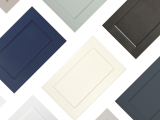A great way to give your kitchen a facelift is to reface your kitchen cabinets. Paying someone to do it, though, can be more than you want to spend. For those who want to reface their kitchen cabinets, have the do-it-yourself spirit, and want to save some money, we are going to share three pro tips on how to get the perfect result you are looking for.
Pro Tip #1: The Right Tools
There are a number of things that can go right in a cabinet reface, and there are many more that can go wrong. The DIY road is great, as it allows you more bang for your buck, with the difference in costs being made up by your own effort.
From the money that you will save, make sure you spend a little bit extra to make sure you have the right tools. There is a reason that the professionals use certain tools, and they use them over and over. You, at minimum, will need: the best quality spray contact adhesive possible. We recommend the 3M brand. A J-roller for getting out bubbles in the veneer and ensuring a good stick. An air nailer with 23 gauge brads or pins (you can rent this for the project, no need to buy). A chop saw, a table saw, an orbital sander and a drill. Hand tools, including screw driver, hammer, scrapers, tape measure, chisel and level. All of these items are necessary to the project at some point or another, so make sure you have them. You can also borrow from a friend or neighbor if you don’t already own some of these tools. Remember the old saying: “A carpenter is only as good as his tools.”
Pro Tip #2: High Quality Materials
When refinishing your cabinets, if you are doing it yourself, you can easily afford to get the best materials possible. The higher quality veneer or laminate you use, the easier it will be to work with, and the better finish it is going to give you. Getting something that looks good but is of cheap quality is the fastest path to frustration we have ever found when refacing cabinets. Here at RTA Cabinet Store, we dislike low quality refacing materials, as we have found through the many horror stories that have been told to us about easily-ruined and non-flat veneers and laminates. Go for quality and don’t let it happen to you.
Pro Tip #3: Many Hands (and Practice) Makes Light Work
While a project of this size is not gigantic, having an extra set of hands or two to help you can cut your time down considerably. We have found that having someone else hold things steady while we are cutting has saved us a faulty cut or a nasty edge more times than we can count. It also helps to keep you focused, which is important in that you will keep your eye on the prize, that perfect reface.
The other side of making your work light, is practicing. Many people jump right into the reface process, which is fine, but could be refined a bit. Take an old cabinet piece, similar to yours if you can find it, and go ahead and strip it down. Learn which techniques work best for you, what angles score the wood and the easiest way to do it. Then try refacing it. You will either make mistakes and learn from them, or secure yourself in the knowledge that when you get to the real deal you are already doing a great job. Good luck on your refacing!










